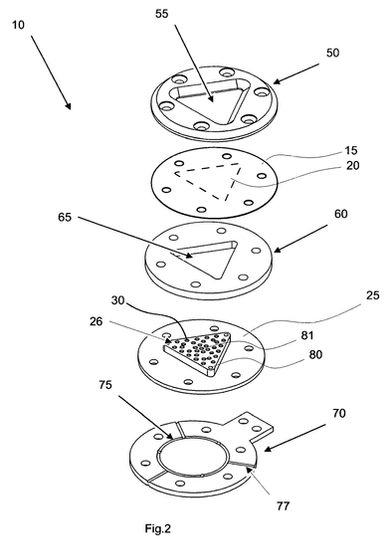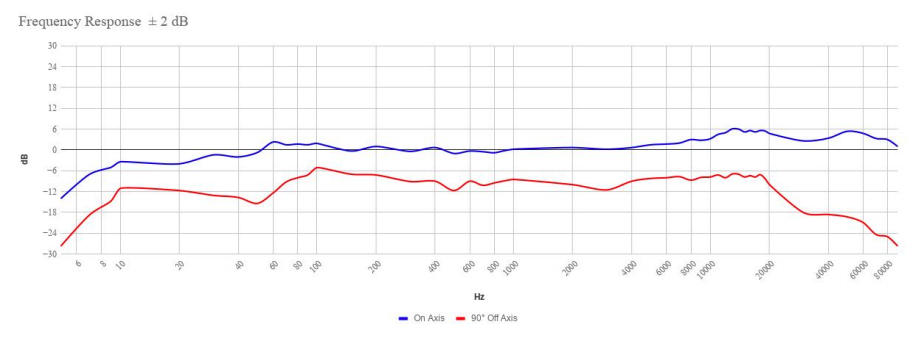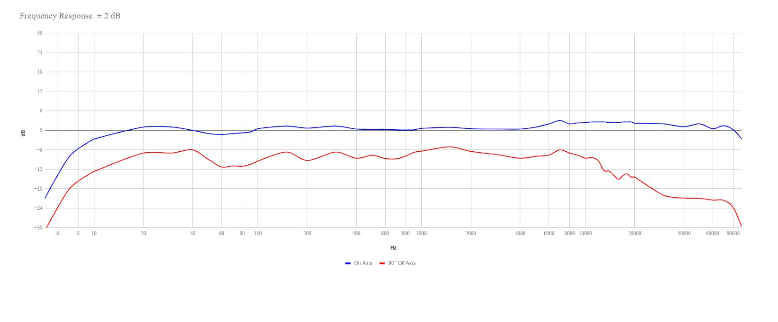Micros Ehrlund : The Complete Guide
- Léo Chupin
- Sep 29, 2022
- 14 min read
Updated: Dec 22, 2023
Absolutely everything you need to know about these new triangular diaphragm mics that everyone is talking about.

Since a few years, a new Swedish brand with a strange name, a growing reputation and a particular distinctive sign has arrived in the sound landscape: a triangular membrane!
Ehrlund microphones are making a name for themselves in the microphone world, but is this a revolution in recording and mixing, an additional tool or just a passing hype?
A bit of history... but not too much!
Göran Ehrlund was born on June 22, 1945 in Eskilstuna, a small Swedish town located about 100 km from Stockholm. At the age of twelve, he developed a passion for sound and built his first dynamic microphone.

In the 1970s, he set up his studio and worked on developing a new acoustic process to detect leaks in high-pressure pipes. One day, while researching how to improve measurement microphones to obtain a linear signal without alteration, he cut a membrane and after several tests, he chose the triangular shape.
During the 80s, he developed the EAP sensor for acoustic instruments, which is still in the catalog. He manufactures them himself and sells them by mail order.

Faced with the success of the latter, he adapted this triangular capsule to make a large-diaphragm condenser microphone. He began developing his first microphones on his own in the 1990s and filed a patent for his triangular membrane. He manufactured 15 of his first microphones. Göran's goal was to create a “ready-to-use” microphone that was easy to use.
The EHR-1, a valve microphone dévelloped with JJLabs and made by VML AB (?)
In 2007, Göran met Sven-Ake, founder and engineer at Research Electronic, a young Swedish research and development company specialized in military technologies. High quality pre-amplification electronics are installed in the microphone. He developed a new model with an outstanding frequency response from 7 Hz to 87 kHz, and an extremely low noise level. The Ehrlund microphones are equipped with military grade electronics and are made of an aluminum alloy, usually used in the aerospace industry.
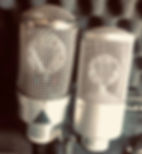
In 2012, after a worldwide patent filing, the Ehrlund brand was officially launched. The mics are handcrafted and assembled by Research Electronic in the town of Siljansnäs, Sweden.

The Magic Membrane: Fact or Fiction?
Ehrlund changes the game with his new capsule, but what is it really like?
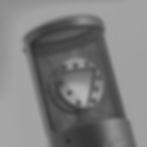
The first static diaphragms invented by Western Electronic and then perfected by Neumann were round. With the CMV3A, U47, M49, U67 and U87, Neumann has made the round membrane a reference... And an obvious one.

In 1982, Milab (PML/Pearl) tries an innovation out of the beaten track with the DC-63 and its rectangular capsule. The result is a much more natural sound without coloration, which seduces the connoisseurs, but the brand does not impose its technology and remains a curiosity.


So the question is: “why change something that seems to work well?”
Indeed, with a round membrane, we hear the recorded instrument, then we mix it. This is possible, thanks to the techniques and materials developed to compensate for the defects of sound recordings (not enough treble, bass management, lack of definition, unpleasant resonances, etc). Despite these imperfections, we manage to produce great records... So everything is fine.
In my opinion, the problem is that we accept the state of the technology of sound recording as such. We've accepted that this is how a microphone should sound, this is how recorded sounds "looks, we know how to correct it and improve it. So the microphone manufacturers continue to take their inspiration from Neumann, AKG and Schoeps. Each one has its own variation, but the capsules remain round and the world of sound does not really evolve.
Why be satisfied with what we have when we could have so much more? That's probably what Goran Ehrlund said to himself just before he revolutionized the world of microphones!
So.
A triangular membrane is very interesting, because there is less resonance and fewer eigen modes. The membrane stops vibrating faster, so the sound is not altered or colored.

Explanations:
What is good for a percussion (which emits sound) is not good for a microphone (which receives sound).
Cymbals, gongs and drums (bass drum, snare drum, djembe, congas and other bongos) are all round! And, spoiler alert : they are round because it sounds better !
why does a round drum sound better?
Beyond the reasons of historically simple manufacturing (a tree trunk, an animal skin and "boom"“we live!), the drums are round, because the walls are at equal distance and angle. Thus the sound waves bounce simultaneously and uniformly inside, which generates a powerful, harmonious, clear sound. This also allows to get lower sounds.
On the contrary, inside a drum which is not round, the wave forms are disorganized, collide and cancel each other out more quickly. In a word: it reasons less.
The drum is the oldest instrument in the world. Among all the variants, epochs and cultures, there are only three "non-round"“boom” ex”eptions that still "sound":e cajon (Peru), the Gome (Ghana) and the pandero jarocho (Vera Cruz, Mexico).
"Not" h“Not”ble mention for the attempts at square and triangular drums which are proof in action that non-round percussion does not sound.

Therefore :
Ehrlund's theory is that what is optimal for a sound-emitting instrument is not efficient for a sound-receiving microphone.
The purpose of a microphone's diaphragm is not for it to amplify itself and vibrate more than necessary. It should only vibrate with the sound it picks up, not more, not less, without alteration or self-generated influence.
Round capsules generate modes and resonances that make the sound less clear, with problems in the frequency response, including inaccurate bass and treble. In addition, it is less responsive to transients.
Nevertheless, the round shape allows for better tuning and distribution of the tension of the membrane. The Ehrlund capsule patent shows that the diaphragm is actually round, stretched over a round support, but with a counterplate and a ring that delimit a triangular resonance zone. The material of the membrane is another of Goran's patented innovations. It is particularly thin and strong. In addition, the triangular shape of the membrane allows for greater tension than traditional capsules, which increases and contributes to the unique sound.

In these videos, Sven Åke Eriksson (the co-founder of the Ehrlund brand) explains in pictures how round capsules work and why triangular capsules work better.
Combined with Sven's pre-amplification technology, you get a microphone with an incredible frequency response, linear from 7Hz to 87kHz! This is completely insane! Of course, the human ear can't hear that far, but it still influences our listening and experience.

The microphones equipped with this capsule have a very natural shelve in the upper register (without any aggressivity) and in the lower register (with a very precise Lowend).
The characteristics of the capsule also allow a great reproduction of the transcient with a very pleasant "crispy"sidewe are in the field of the ASMR!
What first strikes the ears is the reality of the sound captured : a detailed, natural sound, without coloration, with a generous and warm bottom end, without being muddy, with particularly well represented highs, very natural, with lots of air.
The overall sound is amazingly natural and bluffing. As we shall see, this is a real game-changer and a real revolution in the world of audio recording.
The triangular capsule is a real innovation with a considerable added value that has a decisive impact on the sound.
The different models
Warning! The Ehrlund mics, in addition to having a spelling that makes my dyslexia tremble, go against the norm of numbered'named mics like theU47, SM57 and C414. Instead, it uses single letter references: M, H, E, D. Sadly it makes them less easy to identify and remember.

Ehrlund microphones are divided into two main families: “distance” and “proximity” microphones, which are further divided into “studio” and “live” categories.
| | Studio | Live |
|---|---|---|---|
Microphones for | EHR-M | ✓ | |
Instruments, | EHR-M1 | | ✓ |
vocals and distance | EHR-T | ✓ | |
Proximity | EHR-E | ✓ | |
Microphones | EHR-D | | ✓ |
Vocal | Nano | ✓ | |
Microphone | EHR-H | | ✓ |
Of course, live mics work very well in the studio, and vice versa.
The EHR-M
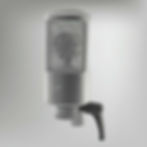
M is for “Main”. The first Ehrlund microphone, released in 2012, is the flagship of the brand. The most versatile mic in the range, intended for studio use (voice, voice-over, acoustic instrument).
So beware, this mic is to die for! Everyone who has heard it has been amazed! Even compared to Dpa and Neumann!

The microphone shines in pair, where it takes all his dimension and render perfectly the sound stage. I have used it for live recordings of acoustic ensembles, for drum overheads, pianos, rooms... A delight!
It excels particularly in the distance shots, too close, it will sound too much... Too much everything (Highs, Lows, etc.). It is a microphone that needs air and space. It will also enhance beautiful acoustic spaces. And even at a fair distance if feels close and warm. I will share with you in a future post some samples and comparisons of it.
It is an exceptional mic , andI use it at each of my sessions.
The key points of the EHR-M:
- The frequency response from 7Hz to 87kHz is amazing!

- Announced as cardioid, the directional lobe shows a shape that tends very slightly towards the hypo-cardioid below 500 Hz and towards the hyper-cardioid above 16kHz. The off-axis response is natural and constant.

- The proximity effect is small, but it is recommended to record from a distance of about 30-50 cm. Too close and the microphone picks up too many unpleasant medium and high frequencies. At 40 cm, you get a surprisingly rich, natural and close sound.
- A sensitivity of 23mV/Pa: you can hear the flies flying!
As a reminder, the ribbons are between 1 and 3 mV/PA (the AEA R84 is at 2,4mV/PA), the dynamics between 1 and 4 mV/PA (the Shure SM57 is at 1,6mV/PA) and the statics range from 8 to 32 mV/PA. The U87Ai is at 28mV/PA with the DPA 4006 approaching 40mV/PA. The output signal is generous and generally requires little gain.
- It has a fairly high output level, which allows you to record at a sufficient level without pushing the preamps and adding distortion. The goal is once again to have the most faithful and unaltered sound possible.
- An incredibly low noise level of 7dBA: no risk of humming if your preamp is a bit low! The U87Ai has 12, the Dpa 4006 has 15.
- It can handle 135dB SPL, which is enough to stick it up to the loudest drummer you know! For comparison, the U87 takes 127dB SPL, the 4006, 147 dB SPL and the Shure beta 52 (the one for the kick) 174 dB SPL!
- It has no output transformer therefore it offer a very clean sound, but with less harmonic distortion: we are not here to color the sound but to have the most natural and transparent sound possible, so it is perfectly coherent.
- No impedance problem! Thanks to the huge work done on the microphone electronics, the frequency response is not altered by the amperage of the preamp used.
- It only requires 1.6mA for its phantom power. Which is apparently super low and super convenient, but in all honesty, I don't know why. Maybe this would allow small USB powered sound cards that have a slightly light 48 volt to power it ? Cool!
- The brand claims that thanks to their technology on the phase, all models are compatible for pairing! There is less than 2% difference between each mic! Which is crazy and allows you to buy your pair separately or in two steps. Sound engineer budget, you know...

My first experience with Ehrlunds was during the “devenir ingé son” training course on stereo recording that took place at the Studio where I work : The Studio de Meudon. Ehrlund France had lent us a pair for the occasion: two EHR-M of different generation and yet the pair was almost perfect!
- It has a sandblasted aluminum body of military quality from the aeronautics industry. The grille is wide enough to avoid reflections around the capsule
- The mic comes in a nice wooden box, first with a stand, then now padded with foam. Not the most practical for my use, I opted for a safety case to carry my pair. Some models came with small caps to protect them from dust.
- Where the microphone fails is in the lack of suspension. Even if it is rarely noticed, a high quality suspension would have been welcome. We can find two rather rudimentary versions that seem to be haphazard and wobbly. The thread is apparently compatible with the mounting system of the TLM 103, 127, 193, named EA2 and EA4, but it remains to be tried if these (expensive) suspensions adapt effectively to the shape of the microphone.
- There is a cute little anti pop, sold at the high price of 120 euros.
There are a few variations of the EHR-M:
- The very first version, made by Göran Ehrlund in his garage. He made about 15 of them. The sound is a bit different, less "high, a bit rougher. It is much heavier, a bigger and wider grill and bears the first logo.

- The EHR-M has undergone many evolutions in 10 years: a new body, the size of the grid, the capsule (2 screws then 3), the capsule holder, the engraving/inscription with the serial number, the fixing system (size of the screw pitch), etc.
- EHR-B: B is for Broadcast version. The only difference is a low cut at 80Hz.
- ISOMIC™, a version sold by Isovox (manufacturer of voice-over isolation boxes), which seems to be halfway between the EHR-M and EHR-E, in a new box with a suitable mount (CloudMount™) to the Isovx box, featuring a double anti-pop (ISOPOP™).

- A custom version with a studio name engraving.

The EHR-M1

The EHR-M1 is the live version of the EHR-M, which perhaps should have been called EHR-ML (L for live).
It is more robust and has a thinner double grille to protect the membrane from dust. They have also incorporated a higher shock resistance.
The directional pattern of the M1 is a little bit more cardioid with a more even lob and less rear pickup.
Frequency response (M on top, M1 on bottom). The response is almost identical between 7Hz and 20kHz? The only difference is from 40kHz...
Don't be surprised by its shape, it is positioned the same way as the EHR-M: in profile! And not like an SM58!

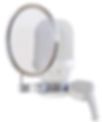
EHR-T

T for "Twin" but it“ld h”ave been called the EHR-M2. Released in 2012, the most expensive microphone in the catalog is visually identical to its little brother. However, it offers a little something extra: It is equipped with a double diaphragm and two outputs allowing to record the two diaphragms separately. Thus, by playing with the volumes and the polarities reversals, one has access to all polarities: Cardioid, Bidirectional, Omnidirectional, as well as all intermediate positions.
So contrary to popular belief, no, this microphone is not stereo!
The frequency response pattern is identical, but the polar pattern is a little different:
The lobe is made as homogeneous as possible to give the most omnidirectional directivity possible. Of course, this is the directionality of only one of the diaphragms. When both capsules are picked up at the same level and in phase, it theoretically looks like this:
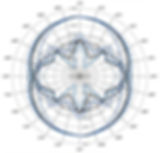
Created at the request of Dutsh Gramophone, who appreciated the EHR-M and expressed the need for an omnidirectional version for orchestral recordings.
In addition to outstanding sound quality, the different outputs allow total control over the sound, the quantity of reverberation and the directivity.
A very impressive microphone that is perfect for orchestral and room recordings.

We are out of the M family!
EHR-E

E for eclectic? Extremely loud and close? We could call it the EHR-C for close micing. But apparently the name comes from "Extended."
Rleased In “Twin”013, the RHR-C is thought for drummers, percussionists, guitar amps as well as horns. "It is a r“ther light and compact studio microphone that will fit most instruments due to its small size," accordin” to the brand. The grille is supposed to be more robust than on the M, where indeed on the M, you can't press too hard on it or it will bend!
To manage diaphony, its directivity is a bit more controlled than on the M.
The response curve is quite close to the EHR-M, but the shelve at the top seems less pronounced and it has almost +2db at 20Hz compared to the M. (E on top, M on bottom)
Everything in this microphone is designed to be able to get close to noisy sources :
- Reduced sensitivity: 8mV/PA.
- Max SPL greatly increased: the threshold for 1% distortion is 137 db, but it only clips at 155 db SPL!
- The first versions of the EHR-E had a "nano xlr"“cable to”get rid of the problems of placing mics under cymbals because of bulky bodies and cables (hello MD-421...). Since then, a standard Xlr plug is in place and is perfectly sufficient to limit the space.
Therefore, suitable for noisy and very close sources, perfect!
A mic that sounds great on snares, kicks, toms, amps and all acoustic instruments.



A solution to the EHR-M's suspension problem has been found for the E: it gives it a very prominent vintage look. However, I don't know where to get it. A 3D printable version will be available.


EHR-D

The EHR-D model, which stands for "Drums", idered by the Swedish manufacturer to be the "live" counterpart the” EHR-E. It retains the attributes of its big brother, but has a compact size and a particularly robust construction to withstand tours and drumstick hits.
Unlike its live companion, the EHR-M1 (also equipped with a rugged grille) it aim in front just like a SM58.
Sounds great on a kick. With the right placement, you don't need another mic!
The graphs are pretty close, even if we can spot slight differences above 20K. The main things to notice is how the signal off axe is lower on the D, almost 5db lower. (D Above, E Below)
The directivities are very close. But just like for the M and M1, the D grab les sound from behind than the E. So as expected, better for live !
EHR H

H is for "Hand," plain and smple. “live”he EHR-H was first tested in 2014, but is being released in 2018. Ehrlu“d states, "The EHR-H is “ portable condenser microphone that has been specifically optimized for live vocal performance, giving it an undeniably powerful and transparent result.
Simply the best vocal microphone for live performance. It has that unmistakable, natural sound that puts the competition to shame. The main technical difference with the other models is its low cut at 80Hz
It lends itself much better to close miking with the qualities of the EHR-E at the expense of the EHR-M which needs more space to sound. With still a negligible proximity effect. A revolution. I use it for lead vocals on all the gigs I do or record, and even in studio. I also sometimes pair it with a U47. The soul of Neumann and the precision of Ehrlund !

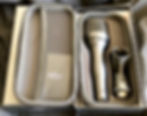


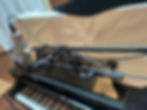
NANO
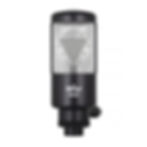
The Nano is the latest release from Ehrlund, a mini version of the H aimed at home studists, podcasters and streamers, as well as low-budget users who want to add an Ehrlund to their palette.
Frequency response is very close to that of the E, especially between 6Hz and 600Hz. However, there's a slight increase in the midrange (1Khz-4Khz) and less High end (10khz-20Khz). This corresponds well to the Ehrlund Nano's intended use (Nano above, Ehrlund-E below).


The Nano's directivity is the narrowest. Much smaller than the E, and even smaller than the H, it's close to Infrarcardioid. Once again, a directional pattern adapted to the purpose of this microphone.


In glossy black, the Nano comes in an attractive cardboard box.

EAP

Ultimate secret weapon, Also worth mentioning is the fantastic Ehrlund Acoustic Pickup, EAP, Goran Ehrlund's first invention. It is a contact microphone which is used like a piezo (but it is not). It is also linear and adapted to acoustic instruments with a resonance box: guitar, bass, violin, cello, double bass...
Thus, the microphone, once fixed with a rubber band, will pick up the vibrations of the acoustic instrument and reproduce a flat frequency response that will not "color" the so“color”
It sounds incredibly good and natural!
A little tip: if you place your finger on the sensor, the sound changes. If you prefer this sound, apply a little gaffer to it.
It is available for sale alone, or with a "DI" (avail“DI” in 48v and battery operated).


"Oreilles délicates" uses it in one of the piano's Ouïes, with stunning results! Listen here
What about the next release? An Ehrlund tube mic?
Ehrlund is actively working on a tube microphone, several prototypes are being tested, a model was presented at NAMM in 2020. For the moment, we only have pictures to show you... But if they manage to combine the naturalness of the EHR-M with the coloring and warmth of the lamps, it will be a killer! The mic I'm looking forward to the most!
See you soon for a new article with a lot of audio samples and comparisons, as well as testimony from experts.
A big thank you to Yann from Yes audio who really helped me when I bought my couple of EHR-M, for my EAP and for my EHR-H (yes I am a fan). If you have any questions about the Ehrlunds or want to buy some, contact him for me at https://www.yes-audio.fr
Some sources, especially photos, were lost during the writing process. If your photo is online, please contact me, so I can credit you or remove it.
Sources :
To geek out like a madman on the round drums:
















